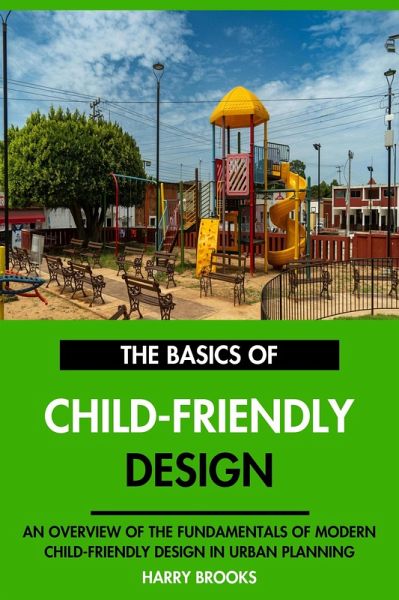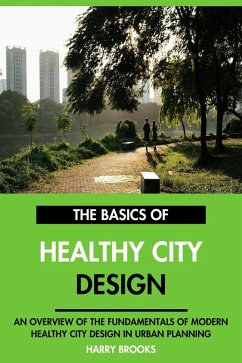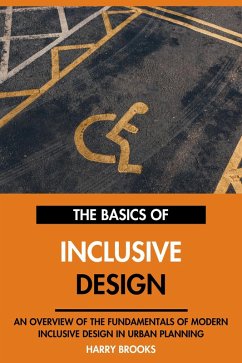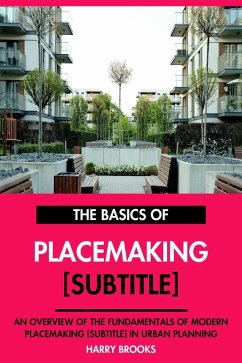
The Basics of Modern Child-Friendly Design: An Overview of the Fundamentals of Child-Friendly Design in Urban Planning. (eBook, ePUB)

PAYBACK Punkte
0 °P sammeln!
In recent years, the conversation surrounding urban design has shifted significantly, with a growing recognition of the importance of creating child-friendly environments. As cities expand and evolve, the need to prioritize the needs of children within these spaces has become increasingly evident. This eBook aims to explore the multifaceted aspects of child-friendly design, providing insights into how urban planners, architects, and communities can collaborate to create spaces that are not only safe and accessible but also engaging and nurturing for children.The journey of child-friendly desig...
In recent years, the conversation surrounding urban design has shifted significantly, with a growing recognition of the importance of creating child-friendly environments. As cities expand and evolve, the need to prioritize the needs of children within these spaces has become increasingly evident. This eBook aims to explore the multifaceted aspects of child-friendly design, providing insights into how urban planners, architects, and communities can collaborate to create spaces that are not only safe and accessible but also engaging and nurturing for children.
The journey of child-friendly design begins with understanding the unique perspectives and needs of children. Unlike adults, children experience their surroundings through a lens of curiosity and playfulness. Their interactions with urban spaces are often shaped by their developmental stages, physical abilities, and social dynamics. Therefore, it is crucial to adopt a holistic approach that considers these factors when designing public areas, parks, schools, and neighborhoods.
Throughout this eBook, we will delve into various aspects of child-friendly design, exploring its significance in urban planning and the principles that underpin it. Each chapter will provide a comprehensive overview of different elements, from safety and accessibility to community involvement and sustainability. By examining real-world examples and best practices, we aim to inspire urban planners and designers to prioritize child-friendly principles in their work.
In addition to the practical implications of child-friendly design, this eBook will also highlight the broader societal benefits that arise from creating environments that cater to children. When urban spaces are designed with children in mind, families are more likely to engage with their communities, fostering social connections and promoting healthier lifestyles. Ultimately, child- friendly design has the potential to transform urban environments into vibrant, inclusive spaces that support the well-being of all residents.
As we embark on this exploration of child-friendly design, we invite readers to consider the role they play in shaping the future of urban spaces. Whether you are an urban planner, architect, educator, or parent, your insights and experiences are invaluable in creating environments that nurture the growth and development of children. Together, we can work towards building cities that are not only livable for adults but also thriving spaces for the next generation.
The journey of child-friendly design begins with understanding the unique perspectives and needs of children. Unlike adults, children experience their surroundings through a lens of curiosity and playfulness. Their interactions with urban spaces are often shaped by their developmental stages, physical abilities, and social dynamics. Therefore, it is crucial to adopt a holistic approach that considers these factors when designing public areas, parks, schools, and neighborhoods.
Throughout this eBook, we will delve into various aspects of child-friendly design, exploring its significance in urban planning and the principles that underpin it. Each chapter will provide a comprehensive overview of different elements, from safety and accessibility to community involvement and sustainability. By examining real-world examples and best practices, we aim to inspire urban planners and designers to prioritize child-friendly principles in their work.
In addition to the practical implications of child-friendly design, this eBook will also highlight the broader societal benefits that arise from creating environments that cater to children. When urban spaces are designed with children in mind, families are more likely to engage with their communities, fostering social connections and promoting healthier lifestyles. Ultimately, child- friendly design has the potential to transform urban environments into vibrant, inclusive spaces that support the well-being of all residents.
As we embark on this exploration of child-friendly design, we invite readers to consider the role they play in shaping the future of urban spaces. Whether you are an urban planner, architect, educator, or parent, your insights and experiences are invaluable in creating environments that nurture the growth and development of children. Together, we can work towards building cities that are not only livable for adults but also thriving spaces for the next generation.
Dieser Download kann aus rechtlichen Gründen nur mit Rechnungsadresse in A, B, CY, CZ, D, DK, EW, E, FIN, F, GR, H, IRL, I, LT, L, LR, M, NL, PL, P, R, S, SLO, SK ausgeliefert werden.













